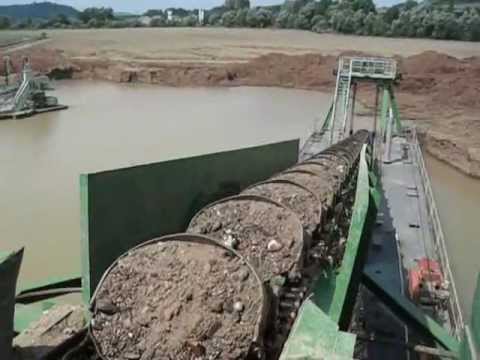Dredging
Contents |
[edit] Introduction
Dredging is the process of excavating and removing sediments and debris from below water level, typically from the bottom of lakes, rivers, harbours, and so on. Dredging is generally necessary because of sedimentation which is the process in which sand and silt washes downstream and accumulates over time in channels and harbours.
Dredging may be carried out for a number of reasons:
- To increase the depth of the bed to allow boats and ships to pass through.
- To obtain aggregates for manufacturing concrete.
- To obtain other materials for use in civil engineering projects.
- To excavate trenches for laying pipelines, cables, and so on.
- To increase channel capacity, thereby helping with flood prevention.
- To prevent the spread of contaminated sediments to other areas of the water body.
- For land reclamation. This is the process of forming areas of land by depositing dredged materials and building them up. One of the most famous projects of this kind was the construction of the Kansai International Airport in Japan, which involved the building of an artificial island in the middle of Osaka Bay.
[edit] Considerations and planning
Before commencing dredging, it is important that site investigations and hydrological surveys are undertaken to assess the likely consequences of removing the material. Likely material movements and the seabed characteristics can be analysed from these surveys.
Some of the main factors which are considered during the planning stages include:
- Site location.
- Depth required.
- Type of material to be dredged.
- Where the dredged material will be deposited.
- If hard rock is likely to be dredged, underwater explosives may need to be used to break them up before being removed by bucket or grab.
[edit] Plant and equipment
The plant used for dredging can be broadly categorised as either suction or digging dredgers.
[edit] Suction dredgers
These are the most commonly used types of dredger. Variations include:
[edit] Trailer suction hopper dredger
This is a self-propelled hull capable of loading its own hold using a centrifugal pump which drags along the bed. It is typically used for dredging sand, silt and some clays. Winches or cranes are used to raise and lower the suction pipes, which have a maximum dredging depth of around 35 m. Hydraulically-operated doors in the hopper’s bottom discharge the material.
The advantage of this dredger is that it can operate in poor sea and weather conditions, and can transport soil over long distances.
[edit] Cutter suction dredger
This is moored using anchor legs and combines suction with a powerful cutting action. It uses a revolving cutting head and is capable of breaking up and removing firmer materials, such as hard clay and soft rock. The material is sucked up a pipe and discharged into barges for disposal. They can be used at maximum depths of around 40 m, and have the advantage of being able to produce a fairly uniform and level bed.
[edit] Digging dredgers
[edit] Bucket chain dredger
This is the common type of dredger, where a chain of buckets continuously scoop material out and raise it above water level before tipping it out onto chutes. (See top image.)
[edit] Bucket dredger
This is also known as a backhoe dredger as it follows the same principles as the land-based backhoe excavator. The advantage of this type of plant is that it can be used to dredge a wide range of materials, including obstacles such as boulders.
[edit] Dragline dredger
This is also modelled on the land-based dragline, and is limited to shallow inland waterways. A bucket is lowered onto the material to be excavated and dragged along its surface by a dragline. Dredged material it typically deposited on the banks of the waterway.
[edit] Floating grab dredger
This uses a grab crane which is mounted on the deck of an anchored or spud-rigged pontoon. The grab is usually a 'clamshell' so as to retain mud and silt. Material is loaded into hopper barges.
[edit] Related articles on Designing Buildings Wiki
- Aggregate.
- Amphibious excavators.
- Caisson.
- Channel.
- Civil engineer.
- Coastal defences.
- Dam construction.
- Desilting.
- Difference between cofferdams and caissons.
- Excavating plant.
- Excavation.
- Land reclamation.
- Pontoon bridge.
- Reservoir construction.
- River engineering.
- Sewer construction.
- Trenching equipment.
- Tunneling.
- Underwater foundations.
- Watercourse.
- Water engineering.
[edit] External resources
- ‘Introduction to Civil Engineering Construction’ (3rd ed.), HOLMES, R., College of Estate Management (1994)
Featured articles and news
Homes England creates largest housing-led site in the North
Successful, 34 hectare land acquisition with the residential allocation now completed.
Scottish apprenticeship training proposals
General support although better accountability and transparency is sought.
The history of building regulations
A story of belated action in response to crisis.
Moisture, fire safety and emerging trends in living walls
How wet is your wall?
Current policy explained and newly published consultation by the UK and Welsh Governments.
British architecture 1919–39. Book review.
Conservation of listed prefabs in Moseley.
Energy industry calls for urgent reform.
Heritage staff wellbeing at work survey.
A five minute introduction.
50th Golden anniversary ECA Edmundson apprentice award
Showcasing the very best electrotechnical and engineering services for half a century.
Welsh government consults on HRBs and reg changes
Seeking feedback on a new regulatory regime and a broad range of issues.
CIOB Client Guide (2nd edition) March 2025
Free download covering statutory dutyholder roles under the Building Safety Act and much more.
Minister quizzed, as responsibility transfers to MHCLG and BSR publishes new building control guidance.
UK environmental regulations reform 2025
Amid wider new approaches to ensure regulators and regulation support growth.
BSRIA Statutory Compliance Inspection Checklist
BG80/2025 now significantly updated to include requirements related to important changes in legislation.























